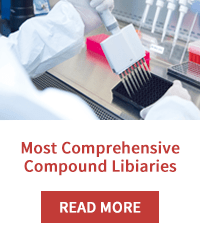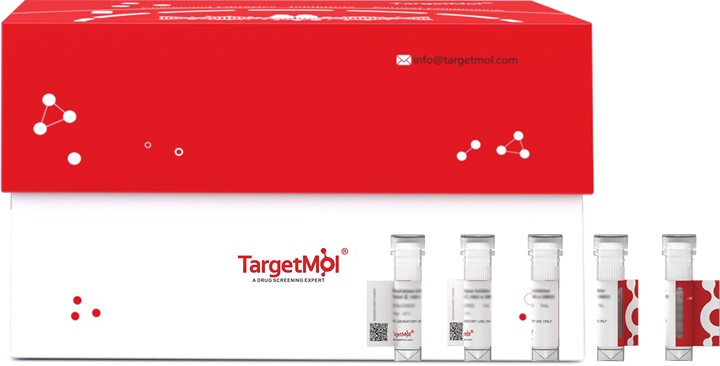

Vascular endothelial growth factor C (VEGF-C) is a member of the VEGF family. Upon biosynthesis, VEGF-C protein is secreted as a non-covalent momodimer in an anti-parellel fashion. VEGF-C protein is a dimeric glycoprotein, as a ligand for two receptors, VEGFR-3 (Flt4), and VEGFR-2. VEGF-C may function in angiogenesis of the venous and lymphatic vascular systems during embryogenesis. VEGF-C protein is over-expressed in various human cancers including breast cancer and prostate cancer. VEGF-C/VEGFR-3 axis, through different signaling pathways, plays a critical role in cancer progression by regulating different cellular functions, such as invasion, proliferation, and resistance to chemotherapy. Thus, targeting the VEGF-C/VEGFR-3 axis may be therapeutically significant for certain types of tumors.

| Pack Size | Availability | Price/USD | Quantity |
|---|---|---|---|
| 50 μg | In stock | $ 296.00 | |
| 100 μg | 5 days | $ 507.00 | |
| 200 μg | 5 days | $ 865.00 | |
| 500 μg | 5 days | $ 1,750.00 |
| Biological Information |
1. Immobilized mouse/rat VEGFC-His at 10 μg/mL (100 μL/well) can bind mouse VEGFR3-Fc , The EC50 of mouse VEGFR3-Fc is 17.4-40.6 ng/mL.
2. Measured in a cell proliferation assay using human umbilical vein endothelial cells (HUVEC). The ED50 for this effect is typically 0.1-0.8 μg/mL.
|
| Description | Vascular endothelial growth factor C (VEGF-C) is a member of the VEGF family. Upon biosynthesis, VEGF-C protein is secreted as a non-covalent momodimer in an anti-parellel fashion. VEGF-C protein is a dimeric glycoprotein, as a ligand for two receptors, VEGFR-3 (Flt4), and VEGFR-2. VEGF-C may function in angiogenesis of the venous and lymphatic vascular systems during embryogenesis. VEGF-C protein is over-expressed in various human cancers including breast cancer and prostate cancer. VEGF-C/VEGFR-3 axis, through different signaling pathways, plays a critical role in cancer progression by regulating different cellular functions, such as invasion, proliferation, and resistance to chemotherapy. Thus, targeting the VEGF-C/VEGFR-3 axis may be therapeutically significant for certain types of tumors. |
| Species | Mouse,Rat |
| Expression System | HEK293 |
| Tag | His |
| Accession Number | P97953-1 |
| Synonyms | vascular endothelial growth factor C |
| Construction | A DNA sequence encoding the mouse / rat VEGFC (NP_033532.1/O35757) (Ala108-Arg223) was expressed fused with a polyhistidine tag at the C-terminus. Mouse and Rat mature VEGFC sequences are identical. |
| Protein Purity |
> 95 % as determined by SDS-PAGE
|
| Molecular Weight | Approxiamtely 14.5 kDa |
| Endotoxin | < 1.0 EU per μg of the protein as determined by the LAL method. |
| Formulation | Lyophilized from sterile PBS, pH 7.4. Please contact us for any concerns or special requirements. Normally 5 % - 8 % trehalose, mannitol and 0. 01% Tween 80 are added as protectants before lyophilization. Please refer to the specific buffer information in the hard copy of CoA. |
| Reconstitution | A hardcopy of datasheet with reconstitution instructions is sent along with the products. Please refer to it for detailed information. |
| Stability & Storage |
Samples are stable for up to twelve months from date of receipt at -20℃ to -80℃. Store it under sterile conditions at -20℃ to -80℃. It is recommended that the protein be aliquoted for optimal storage. Avoid repeated freeze-thaw cycles. |
| Shipping |
In general, recombinant proteins are provided as lyophilized powder which are shipped at ambient temperature.Bulk packages of recombinant proteins are provided as frozen liquid. They are shipped out with blue ice unless customers require otherwise. |
| Research Background | Vascular endothelial growth factor C (VEGF-C) is a member of the VEGF family. Upon biosynthesis, VEGF-C protein is secreted as a non-covalent momodimer in an anti-parellel fashion. VEGF-C protein is a dimeric glycoprotein, as a ligand for two receptors, VEGFR-3 (Flt4), and VEGFR-2. VEGF-C may function in angiogenesis of the venous and lymphatic vascular systems during embryogenesis. VEGF-C protein is over-expressed in various human cancers including breast cancer and prostate cancer. VEGF-C/VEGFR-3 axis, through different signaling pathways, plays a critical role in cancer progression by regulating different cellular functions, such as invasion, proliferation, and resistance to chemotherapy. Thus, targeting the VEGF-C/VEGFR-3 axis may be therapeutically significant for certain types of tumors. |
bottom
Please read the User Guide of Recombinant Proteins for more specific information.
VEGFC Protein, Mouse/Rat, Recombinant (aa 108-223, His) vascular endothelial growth factor C recombinant recombinant-proteins proteins protein
